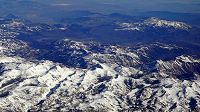NY Times: Sierra Nevada Snow Won’t End California’s Thirst
11 Apr 2016
News Source: The New York Times
New York Times reporter, Henry Fountain spoke with Southern Sierra CZO PIs Roger Bales and Martha Conklin and investigtor Mohammad Safeeq as they toured the state of the Sierra snowpack within the SSCZO with field manager Erin Stacy.
Sierra Nevada Snow Won’t End California’s Thirst
By Henry Fountain
April 11, 2016
YOSEMITE NATIONAL PARK, Calif. — Thanks in part to El Niño, snowpack in the Sierra Nevada is greater than it has been in years. With the winter snowfall season winding down, California officials said that the pack peaked two weeks ago at 87 percent of the long-term average.
That’s far better than last year, when it was just 5 percent of normal and Gov. Jerry Brown announced restrictions on water use after four years of severe drought. But the drought is still far from over, especially in Southern California, where El Niño did not bring many major storms.
Despite the better news this year, there are plenty of worrying signs about the Sierra snowpack, which provides about 30 percent of the water Californians use after it melts and flows into rivers and reservoirs, according to the state Department of Water Resources.
Mohammad Safeeq and Erin Stacy from the University of California, Merced, measuring snowpack in the Sierra Nevada, an important water source. Credit Jim Wilson/The New York Times
Many of those concerns stem from the effects of climate change and the structure of Sierra forests, which can influence how the snowpack accumulates and melts. Because the snow, in effect, serves as a reservoir that is released over time, any changes can affect how much water is available for people, industry and agriculture, and when.
“We’ll be getting more rain and less snow here,” said Roger C. Bales, a professor at the University of California, Merced, and a principal investigator with the Southern Sierra Critical Zone Observatory, which studies snowpack and other water-related issues. “That means less snowpack storage and faster runoff.”
To continue reading this article, please visit The New York Times.
A version of this article appears in print on April 12, 2016, on page D1 of the New York edition with the headline: Uncertainty in the Sierra.
News Source:
READ MORE from The New York Times >>
News Category:
RESEARCH |
PEOPLE |
EDUCATION/OUTREACH
People Involved
CZO
-
Sierra, INVESTIGATOR
-
Sierra, INVESTIGATOR
-
Sierra, INVESTIGATOR
-
Sierra, STAFF
Explore Further






